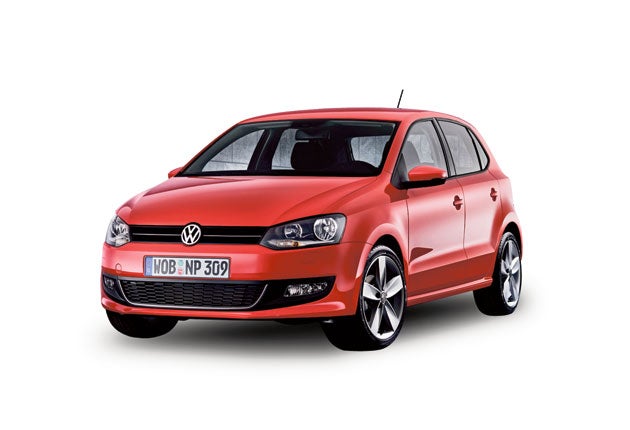Volkswagen Mini-Golf
Watch out! This VW super-mini is no lightweight

A Volkswagen Polo used to be the smartest of smart super-mini buys. Not the fastest or flashiest, nor even the most comfortable or best to drive, but a beautifully-made, sophisticated little car with all the understated classlessness of its bigger Golf sibling.
But in recent times the mini-Golf has fallen right off the radar. Despite a mid-term visual refreshment, the generation launched in 2002 was just too dull to be noticed. Many of us had forgotten all about the Polo – and then, at March's Geneva motor show, Volkswagen sprang a surprise and revealed a new one.
Well, we didn't see that coming even though it was long overdue. And what has come is a car once again clearly related to the Golf but this time with a strong identity of its own.
The new Polo has a squat stance with wheels set well apart, and it reflects today's trend for car-size inflation by being as big as a 1990s Golf Mk3. More welcome is that a typical new Polo weighs about 7 per cent less than the previous one. Very high-strength steel, which can be used in thinner sheets, is one reason for this; an emphasis on smaller, lighter but no less powerful engines is another.
Volkswagen makes much of the Polo's greenness, or more accurately blueness. This time around, the ultra-economical BlueMotion version (available next year) produces just 87g/km of CO2 on the official tests, equating to 85.5mpg, helped by a stop-start system and regenerative braking. It has a 1.2-litre, three-cylinder turbodiesel engine, and will be the most frugal super-mini (if that term still applies) that you can buy.
The other available diesels are new 1.6-litre units, all rated at 109g/km even though they come in three different outputs (75, 90 and 110bhp), and again all fitted with stop-start. It's hard to understand why you would want the least powerful one, and equally hard to fathom why the most powerful one won't initially be offered in the UK apart from the fact it might cost slightly more to insure.
As for petrol engines, the 1.2-litre, three-cylinder unit comes in 60 or 70bhp form again with identical rated emissions (128g/km). There's a new 1.4 making an unimpressive 85bhp and a better 139g/km, but the petrol-fuelled star is a new 1.2-litre, four-cylinder, turbo-charged engine with 105bhp and a 129g/km CO2 score. It's this intriguing TSI version, from £13,500, I try first, in the grandest of four trim levels.
Inside, a padded dashboard and finely detailed fittings impart an upmarket aura, but it's a shame the padding couldn't extend to the door trims whose hardness breaks the spell. But there's a good-size glovebox, the boot has an adjustable-height floor – and there's plenty of people-space. It's clear as soon as you drive off that this is a strong, sturdy car –which is, incidentally, the first car in its class designed to meet the new, tougher five-star rating in the EuroNCAP crash tests. It's quiet and it rides smoothly over bumps, more so if not fitted with the optional, and hefty, 17-inch alloy wheels of this test example, and it steers with a more natural feel than some rivals because it has electro-hydraulic, rather than purely electric, power assistance. All new Polos come with both electronic stability control and a device which pressurises the brakes' hydraulics to stop you rolling back on a hill. Learners will love them.
The little turbo engine feels smooth and lively, with the vigour of a typical non-turbo 1.6 and relaxed cruising in its sixth gear; a seven-speed DSG gearbox is optional with this and some other engines. This particular Polo feels perky enough to be fun as well as frugal, but next year's 170bhp GTI version, with a 1.4-litre engine featuring both supercharger and turbo- charger, will be more so.
And the diesels? I tried the two extremes: the 110bhp one, showing the easy thrust typical of a good modern diesel; the 75bhp one feeling like the same engine with a handkerchief placed over its mouth. And I got a quick go in a pre-production Blue-Motion. Once I'd re-learnt the driving technique required when there are such big gaps between gear ratios (designed for very low engine speeds when cruising), it proved entirely usable as well as fabulously parsimonious. My halo has never been bluer.
The Rivals
Ford Fiesta 1.6 Titanium: £14,195
More dramatically styled, more fun to drive, with sharper handling and more power. An ultra-modern interior, but feels less "premium" than a Polo.
Mazda 2 1.5 Sport: £12,042
Looks frisky and modern, feels brisk and fun to drive because it shares much with the Fiesta. Interior feels the cheapest here. Good value though.
Peugeot 207 1.6 Sport: £13,845
Looks enormous next to the old 205, gives good first impressions but lacks storage space, driving satisfaction and in-depth quality.
Subscribe to Independent Premium to bookmark this article
Want to bookmark your favourite articles and stories to read or reference later? Start your Independent Premium subscription today.

Join our commenting forum
Join thought-provoking conversations, follow other Independent readers and see their replies